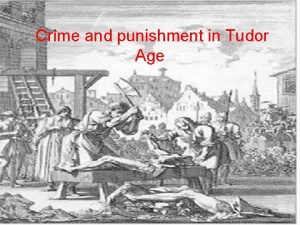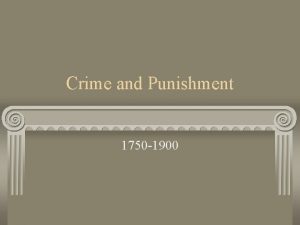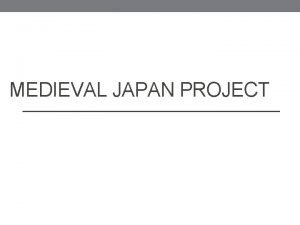Medieval Crime and Punishment Europe Japan Crime in









- Slides: 9

Medieval Crime and Punishment Europe Japan

Crime in Medieval European punishment was usually very harsh and very public with consequences for the more mild crimes still being of a harsh nature. This was due to the belief that people would not misbehave if they knew first hand what would happen if they broke the law. This meant that many of these gory punishments were made into a public event.

Crime in Medieval Japan Similar to the Europeans Japanese punishment was also made very public however it was not to deter more crime but to strip the victim of honour and pride, two very important things in Medieval Japan. Samurai and other high-ranking Japanese were given the option of Seppuku, this was the option of committing suicide in privacy to avoid a public and humiliating death.

Forms of European punishment Coffin Torture Serious crimes, such as heresy or blasphemy were punished by death inside the coffin, which was a steel cage in the shape of a human, where the victim was placed under the sun allowing birds or animals to eat his or her flesh. Sometimes onlookers would throw rocks and other objects to further increase the pain.

Spanish boot Was used as a tool of interrogation where a wooden cast with wooden or metal spikes hammered into it was place around the victims legs and slowly tightened until they confessed or passed out.

The Rack consisted of a wooden frame usually with two ropes fixed to the bottom and another two tied to a handle in the top. As the torturer turned the handle, the ropes would pull the victim's arms, eventually dislocating bones with a loud crack. If the torturer kept turning the handles (they often went too far) some of the limbs were torn right off the body.

Forms of Japanese punishment Exile, Forced Labour and Imprisonment Japanese convicts could be exiled to an island or forced to work in mines or other strenuous labour camps, unlike the Europeans, Japan maintained jails so imprisonment was still a main form of punishment and there was less use for the creation of different instruments of torture.

Flogging and Amputation. These were the main forms of corporal punishment in medieval Japan however the use of amputation died out due to the use of flogging as a substitute. Samurai and Priests were exempt from flogging and a person could only be sentenced to 100 lashes at a time.

Research Activity Create a poster using www. glogster. edu on two different forms of Medieval punishment. Include the following information: • Name of punishment • Process of punishment • One other piece of interesting information you found during your research
 Crime and punishment in medieval japan
Crime and punishment in medieval japan Medieval crime and punishment facts
Medieval crime and punishment facts Wjec criminology unit 4
Wjec criminology unit 4 Crime and punishment revision guide
Crime and punishment revision guide Who is razumikhin
Who is razumikhin Crime and punishment in tudor times
Crime and punishment in tudor times Wjec criminology unit 4 past papers
Wjec criminology unit 4 past papers Gcse history past papers edexcel
Gcse history past papers edexcel Kahoot crime and punishment
Kahoot crime and punishment Crime and punishment 1750 to 1900
Crime and punishment 1750 to 1900

















